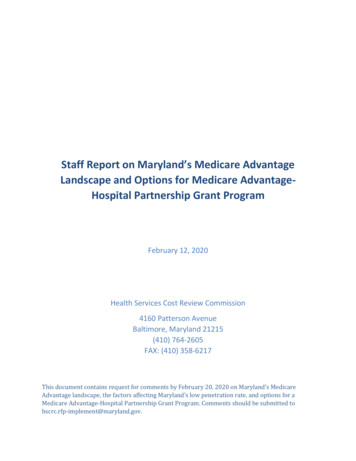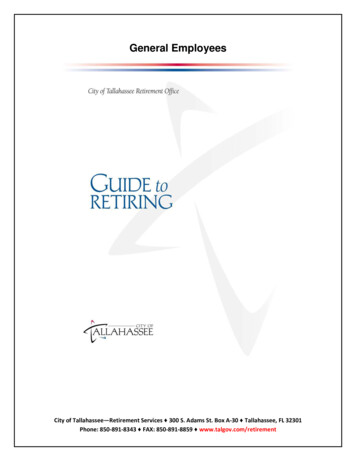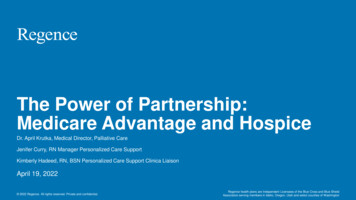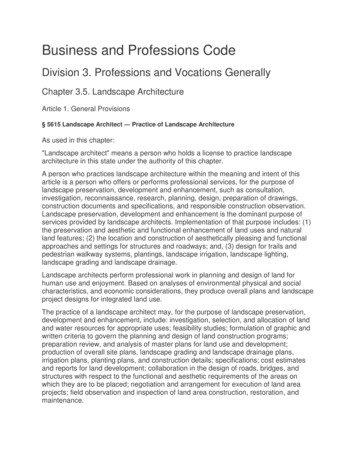
Transcription
Staff Report on Maryland’s Medicare AdvantageLandscape and Options for Medicare AdvantageHospital Partnership Grant ProgramFebruary 12, 2020Health Services Cost Review Commission4160 Patterson AvenueBaltimore, Maryland 21215(410) 764-2605FAX: (410) 358-6217This document contains request for comments by February 20, 2020 on Maryland’s MedicareAdvantage landscape, the factors affecting Maryland’s low penetration rate, and options for aMedicare Advantage-Hospital Partnership Grant Program. Comments should be submitted tohscrc.rfp-implement@maryland.gov.
Staff Report on Medicare Advantage in MarylandTable of ContentsRequest for Comments on Analysis and Options3Background on Medicare Advantage5Medicare Advantage Payment System5Medicare Advantage Star Program6Medicare Advantage and the Total Cost of Care Model7Medicare Advantage Penetration in Maryland7Impact of the Benchmark for High-Cost Counties10Impact of High-Quality Plans on Medicare Advantage Enrollment12Impact of Hospital Rate-Setting on Medicare Advantage15Grant Program for Medicare Advantage17Terms and Conditions of the Medicare Advantage Grant Program18Funding for the Medicare Advantage Grant Program19Appendix 1: CMS Star Ratings for 202021Appendix 2: Number of Medicare Advantage Plans by County232
Staff Report on Medicare Advantage in MarylandRequest for Comments on Analysis and OptionsCommissioners have expressed concerns about the low levels of enrollment in Maryland byMedicare beneficiaries into Medicare Advantage plans. This is of potential concern becauseMedicare Advantage plans can help manage the care of their enrollees and are sometimes able tooffer enrollees reduced cost sharing and enhanced benefits. While all Maryland counties haveaccess to a Medicare Advantage plan, less than half of Maryland Medicare beneficiaries haveaccess to a 0-premium Medicare Advantage plan.1,2The Commission seeks to understand why the penetration rate of Medicare Advantage plans is solow in Maryland and what actions the State should consider to spur greater enrollment. Thepotential actions may differ for what the State does in the short run versus the longer run. Inresponse to the Commission’s request to develop options for short-run interventions, staff havecompiled various Commissioners’ insights to produce potential options that appear in this report.The initial HSCRC staff analysis included in this report finds that the enrollment rates ofMedicare Advantage plans nationally, as well as in Maryland, are most strongly correlated withthe quality of the Medicare Advantage plans in an area. No correlation appears between theaverage Medicare fee-for-service (FFS) total cost of care (TCOC) in an area and the resultingbenchmark that Medicare Advantage plans receive on their payments from the Centers forMedicare & Medicaid Services (CMS). In addition, although Maryland’s all-payer hospital ratesetting prohibits Medicare Advantage and other payers from negotiating rates below those set bythe Commission, research indicates that nationally Medicare Advantage plans generally payhospitals the FFS rate3.On the other hand, Maryland has some Medicare Advantage plans that are relatively new to themarket, and it generally takes several years for new plans to attain the quality rankings that aremost attractive to prospective enrollees and that provide the plan with quality-related bonuspayments from CMS. Multiple Medicare Advantage plans in Maryland have increased theirquality scores and are on the cusp of attaining that 4-star rating.Moreover, hospital global budgets in Maryland mean that hospitals are better aligned with payersand consumers to avoid potentially avoidable hospital utilization. For hospitals to receive theirGlobal Budget Revenue (GBR), as hospital volumes decline, hospital prices on individual mayservices rise. Overall, payers and consumers should benefit as the Commission sets an AnnualUpdate Factor that produces greater savings than would otherwise have occurred, balancingJacobson, et al. (2020). “Medicare Advantage 2020 Spotlight: First Look.” Data Note, Kaiser Family Foundation.October 24, 2019: age-2020-spotlight-first-look-data-note/2Medicare Advantage can provide extra benefits if beneficiaries pay for those benefits (similar to a standalonesupplemental plan) but beneficiaries incur those additional costs unless the plan earns a rebate by bidding below theMedicare Advantage benchmark.3Berenson et al. (2015). “Why Medicare Advantage Plans Pay Hospitals Traditional Medicare Prices.” HealthAffairs, 34(8): 1289-1295. 713
Staff Report on Medicare Advantage in Marylandsustainable levels of payments to hospitals with adequate savings to payers. However, this alsomeans that if Medicare Advantage plans cannot reduce hospitalizations faster than other payers,the mechanics of the GBR can result in their hospital spending being higher than in the absenceof the GBR.This staff report seeks comments on:A. The state of the Medicare Advantage market in Maryland and the factors affectingit, including the findings in this staff report;B. the roles of Medicare Advantage plans versus hospitals in Maryland under theTCOC Model;C. Long-term and short-term options and issues to increase Medicare Advantageenrollment in Maryland and how such options could be implemented in a way thatis budget neutral to the federal government; andD. A specific short-term option for the Commission to implement a MedicareAdvantage-Hospital Partnership Grant Program that awards selected hospitalswith funding through rates. The primary purpose of this program would be toimprove partner plans’ quality performance as measured by the MedicareAdvantage Star Ratings program and to improve health outcomes for themembers they serve. Specifically, the grant program could be structured asfollows:1. Provide funding to hospitals partnering with a Medicare Advantage planfor no more than two years (CY2021 and CY2022);2. Provide an amount of up to 5 percent of the county-level FFS costsincluded in the Medicare Advantage Ratebook multiplied by the numberof enrollees in the plan;3. Recapture grant funding from the hospital if the Commission-specifiedtargets for the partner plan are not attained regarding:a) Improvement in quality scores;b) Improvement in enrollees’ use of Annual Wellness Visits; andc) Maintenance of enrollment levels; and4. Ensure budget neutrality by reducing the RY 2021 and RY 2022 UpdateFactors by an amount necessary to offset the aggregate amount of theMedicare Advantage-Hospital Partnership Grants issued — but increasingfuture Update Factors by any amounts recaptured if targets are notattained.4
Staff Report on Medicare Advantage in MarylandBackground on Medicare AdvantageMedicare Advantage is a program that allows Medicare beneficiaries to receive health insurancecoverage provided by a private insurer, rather than traditional fee-for-service (FFS) Medicare.Under Medicare Advantage, private health plans are paid a per person monthly amount toprovide all Medicare-covered benefits (except hospice) to beneficiaries who enroll in their plan.The plan is at risk for financial losses if aggregate costs exceed the aggregate capitatedpayments. Conversely, the plan can retain profits if its costs are less than the payments it receivesfrom CMS.The Medicare Advantage capitation rate is determined by a plan’s benchmark and the plan’s bid.The benchmark represents the maximum amount that CMS will pay the Medicare Advantageplan. The plan’s bid represents the amount that the plan believes it requires to cover its enrollees.If the plan’s bid is less than the benchmark, a portion of the difference between the plan’sbenchmark and the plan’s bid is returned to CMS as additional savings and a portion is rebated tothe Medicare Advantage plan’s enrollees. The rebate must be returned to the MedicareAdvantage plan’s enrollees in the form of either reduced cost sharing or in the form ofsupplemental benefits.CMS makes adjustments to the Medicare Advantage capitation rate based on the quality of theMedicare Advantage plan. Each Medicare Advantage plan receives from 1 to 5 stars. Higherstars (4 or higher) earn the Medicare Advantage plan a positive adjustment to its benchmark andalso higher rebates for its enrollees.Medicare Advantage Payment SystemThe Medicare Advantage benchmark is set separately by county based on the FFS spending inthat county. To determine per capita spending for each county, the national estimated level ofFFS per capita cost is multiplied by a county-level geographic index, which is calculated using afive-year rolling average (2013 to 2017 for the 2020 benchmarks) of claims data for beneficiariesin original Medicare in the county and includes risk adjustment. To project the FFS spending inthe county during the upcoming year, CMS calculates the growth in fee-for-service costs. Theestimated county-level FFS costs are equal 2019 FFS costs times the geographic index times theprojected FFS growth trend.Two adjustments are made to the county-level estimates FFS costs to derive the MedicareAdvantage benchmarks. First, counties are broken into quartiles of FFS costs, with thebenchmark equal to FFS costs multiplied by a percentage (115, 107.5, 100, and 95 percent)based on which quartile the county is in. In other words, a plan in a county in the first (lowest)quartile will receive 115 percent of the estimated FFS costs; a county in the fourth (highest)quartile will receive 95 percent of the estimated FFS costs. Second, each plan that has receive 4 5
Staff Report on Medicare Advantage in Marylandstars will receive a quality adjustment to their Medicare Advantage benchmark.4 For example, aplan that would have otherwise received 95 percent of the estimated FFS costs for a county couldinstead receive 100 of the estimated FFS costs for a county. Additionally, a plan with 4 starsreceives additional rebates that are passed on to the plan’s enrollees. A 4 or 4.5 star plan receives65 percent of the difference between its bid and the benchmark while a 5 star plan receives 70percent of the difference, all of which are passed on to the plan’s enrollees. A plan with less than4 stars receives 50 percent of the difference between its bid and the benchmark. The combinationof a higher benchmark and a greater rebate share means that 4 star Medicare Advantage planscan offer significantly more rebates than a plan with less than four stars.5The final benchmark for Medicare Advantage plans is the estimated FFS costs in the county withthe quartile and quality adjustments applied. The payments a plan receives will be equal to itsbid. If the bid exceeds the benchmark, CMS will pay the benchmark and the enrollee will pay apremium equal to the difference. If the bid is less than the benchmark, CMS will pay the plan’sbid plus the rebate amount. Plans that bid less than the benchmark are known as 0-premiumplans since beneficiaries to not pay a premium to enroll. The plans payments are risk adjustedusing the CMS Hierarchical Conditions (HCC) Model.6Medicare Advantage Star ProgramThe Medicare Advantage star rating is a critical component of the Medicare Advantagereimbursement system. The star ratings are based on nearly 50 different measures7 that areaggregated into an overall star rating. Each individual measure is given a star rating from 1 to 5.CMS uses a clustering algorithm to identify cut-points in the measure values. These cut-pointsare designed to minimize variance within each cluster. In other words, the clustering algorithmidentifies where the cut points should be so that plans within the same star rating have measureresults that are relatively close to each other. Based on the cut-points identified by CMS, each4The ACA also requires that benchmarks (including any quality adjustment) be capped at the level they would havebeen in the absence of the ACA. In 2018, in half of U.S. counties, the MA benchmark adjusted by a 5 percentagepoint quality bonus is constrained by the pre-ACA benchmark cap. However, in 2020 no Maryland counties aresubject to this cap.5For example, in general, a 4 star plan that had the exact same bid as a less-than-4 star plan would receive thesame capitation payment from CMS. But the plan would be able to offer an additional rebate equal to 3.125 percentof premium as supplemental benefits to enrollees because the 4 star plan would receive a 5 percentage point qualityadjustment to the benchmark and 65 percent of the difference between its bid and the benchmark as a rebate to passon to enrollees.6Because plan payments depend on the number and severity of conditions for Medicare Advantage enrollees,Medicare Advantage plans are highly incentivized to code more accurately/intensely than providers in FFSMedicare. This has resulted in an upward trend in Medicare Advantage risk scores relative to the FFS population. Inorder to avoid overpaying Medicare Advantage plans due to the coding intensity, CMS reduces the plan’s averagerisk score by a coding intensity factor.7Not every plan will be evaluated on all 47 measures. For instance, plans that do not offer a Part D component willnot be measured on the Part D specific measures. See the Medicare 2019 Parts C and D Star Ratings TechnicalNotes: gs-Technical-Notes-Oct-10-2019.pdf6
Staff Report on Medicare Advantage in Marylandindividual measure receives a star rating. A list of star measures, their CMS assigned weights,and the time period that the measure is based on is shown in Appendix 1.The overall star ratings are based on the weighted average of the individual ratings on each of themeasures. The weights are set by CMS with the highest weight given to the improvementmeasures, followed by the outcomes and intermediate outcomes measures, then by patientexperience/complaints and access measures, and finally process measures. Two adjustments aremade. First, to reward consistently high performance, contracts that have both high and stablerelative performance earn a reward factor. Second, a technical adjustment based on thepercentage of Low Income Subsidy and Dually Eligible beneficiaries is made while CMScompletes a comprehensive review of the Medicare Advantage star program as mandated by theIMPACT Act.Medicare Advantage and the Total Cost of Care ModelMaryland is unique in that both the Medicare FFS population and the Medicare Advantagepopulation is capped by a benchmark. Under the Maryland Model, the State must ensure thatMedicare FFS total cost of care grows less than the national average growth rate relative to a2013 baseline. The State’s performance under the Maryland Model is calculated based onbeneficiaries who have Medicare Parts A or B and are not enrolled in Medicare Advantage. Thusincreased enrollment is potentially complementary to the State’s success under the MarylandModel.If high cost beneficiaries enroll in Medicare Advantage, then the total cost of care measuredacross the FFS population will decline and appear as savings under the waiver test. Conversely,if low cost beneficiaries enroll in Medicare Advantage, then the total cost of care in FFS willincrease and appear as a dissaving under the waiver test. Due to data limitations, staff were notable to analyze the costs of beneficiaries leaving FFS to enroll in Medicare Advantage. Theplan’s HCC scores could be a proxy for their expected FFS costs but staff suspects that riskscores in Maryland may be unreliable and Medicare Advantage coding intensity would need tobe taken into account. In general, staff expects that special needs plans, and particularly dualsplans, would be a net benefit to the Maryland Model waiver tests.Medicare Advantage Penetration in MarylandMedicare Advantage penetration in Maryland is low relative to the nation. Nationally, 34 percentof all Medicare beneficiaries have enrolled in a Medicare Advantage plan, while only 11 percentof Medicare beneficiaries in Maryland enrolled in a Medicare Advantage plan. There are fewobvious patterns associated with low Medicare Advantage penetration, with the exception of thePlain States, which are rural states with few large metropolitan areas that tend to have MedicareAdvantage penetration. The two concentrations of low Medicare Advantage penetration inMaryland, Delaware, and Virginia, and in Vermont and New Hampshire, appear to be outliers.7
Staff Report on Medicare Advantage in MarylandFigure 1: Medicare Advantage Penetration in the US as of 20189%12%21%22%13%11%Source: HSCRC analysis of CMS’ State and County Enrollment FilesGrowth in Medicare Advantage in Maryland has been higher than the national average. In 2014,the national penetration in Medicare Advantage was 30 percent while it was only 9 percent inMaryland. By 2018, the penetration rate in Medicare Advantage had grown to 34 percentnationally (13 percent increase) and grew to 11 percent in Maryland (22 percent increase). Thegrowth in Medicare Advantage reflects a changing market. In 2015, only 5 organizations (Aetna,Cigna, Humana, Erickson, and MedStar) offered Medicare Advantage plans in the state. In 2017,Johns Hopkins and the University of Maryland entered the market. Simultaneously, Unitedentered the market by acquiring the Erickson plans. In 2018, Kaiser Permanente entered theMedicare Advantage market.8 In 2019, MedStar exited the market and the University ofMaryland closed their Medicare Advantage plans except for a duals plan.Appendix 2 shows the availability of plans by county since 2015. There are a relatively largenumber of Medicare Advantage plans available in the urban counties. But in some rural areasthere are no traditional Medicare Advantage plans, only special needs plans. As a result,Medicare Advantage penetration is concentrated the urban counties. The highest penetrationrates in Maryland are 18 percent in Baltimore City, 16 percent in Prince George’s County, 13percent in Baltimore County, and 12 percent in Montgomery County. Conversely, the lowestpenetration rates are 2 percent in Saint Mary’s, and 5 percent in Allegheny, Calvert, and Kent8Kaiser Permanente offered Section 1876 Cost Contract Plans in Maryland. CMS terminated their cost basedcontracts on December 31, 2018 as required by the 2015 Medicare Access and CHIP Reauthorization Act.8
Staff Report on Medicare Advantage in MarylandCounties. This follows a national pattern where rural counties have about 10 percentage pointsless penetration (24 percent) than the national average (34 percent).The availability of highly rated Medicare Advantage plans was limited prior to Kaiser’s entry tothe market. In 2018, United and Humana both offered plans with 4 stars (26 percent) of theplans offered on the market.9 The presence of United and Humana overstates the quality of plansthat are general available to Maryland beneficiaries because those plans were only offered to alimited segment of the market. The United plan was available to residents of Erickson Living,and the Humana plan was available only in Carroll, Fredrick, Garrett, and Washington Counties.Overall, the enrollment-weighted average star rating was 3.1 in Maryland.10 Nationally, there ismore access to 4 star plans; 44 percent of all plans earned more than 4 stars, 4 percent of plansearned 5 stars, and the enrollment-weighted average was 4.1 stars—one star above Maryland.11Figure 2: Percent of Plans by Star Ratings in Maryland and the Nation, 0%0%4%3%5%1% 0%2 Stars0%2.5 Stars3 Stars3.5 StarsNTL4 Stars4.5 Stars5 StarMDSource: HSCRC analysis of CMS Landscape Files and CMS Star Rating Fact Sheet 2018.Note: This analysis excludes employer-based (group) Medicare Advantage plans, Special Needs Plans (SNPs),other plans not available for general enrollment, and new market entrants and does not include Kaiser, whichwas converting from a cost plan to an HMO.9This excludes new entrants since they typically do not have enough data to assign a star rating or are in the processof converting from a cost plan.10HSCRC Analysis of the CMS Landscape & Enrollment Files11See CMS Star Rating Fact Sheet: Ratings-Fact-Sheet-.pdf9
Staff Report on Medicare Advantage in MarylandThe availability of high-quality health plans is a significant issue for consumers. MedicareAdvantage can offer a richer benefit package and lower cost sharing than traditional FFSMedicare. However, the benefits offered by the Medicare Advantage plans is dependent on theirstar ratings for two reasons: First, highly rated Medicare Advantage plans have a significantmarketing advantage; and second, the plans with 4 stars receive a higher benchmark and canprovide additional supplemental benefits or lower cost-sharing to enrollees. In Maryland, morethan half of beneficiaries lack access to a 0-premium plan (e.g., a plan that offers eithersupplemental benefits or lower cost sharing). This indicates that enrolling in a MedicareAdvantage plan costs beneficiaries more than enrolling in Medicare FFS. Additionally,beneficiaries cannot get extra benefits – such as vision or dental – without paying an additionalpremium for the benefits.Impact of the Benchmark for High-Cost CountiesOne hypothesis is that Medicare Advantage penetration in Maryland is relatively low because themajority of Maryland counties are in the top quartile of all counties in terms of FFS costs. As aresult, the Medicare Advantage payment benchmark for those counties is equal to 95 percent ofthe FFS costs. Figure 3 shows the Medicare Advantage benchmark by state, which reflects thequartile adjustments.12 Even with the 5 percent reduction for being in the highest quartile in mostcounties, Maryland has the highest Medicare Advantage benchmark in the nation.12Each county is weighted by the number of Medicare Advantage eligible beneficiaries to create a weightedbenchmark by State.10
Staff Report on Medicare Advantage in MarylandFigure 3: Weighted Medicare Advantage Benchmarks by StateMedicare Advantage Benchmark 1,200 1,000 800 600 400 200 0MD NV MA NE NJ FL IL DE CO NH GA ID ND WA IN AZ NC AL OH UT RI OR WV VT WI HISource: HSCRC analysis of CMS 2020 Ratebook.Medicare Advantage penetration may be lower in the 95 percent benchmark counties if plans areunable to make up the 5 percent reduction relative to FFS costs. However, as shown in Figure 4,there is no statistical relationship between the FFS quartile and the Medicare Advantagepenetration. This implies that Medicare Advantage plans can operate effectively – and likelyprofitably13 – in counties that receive a 95 percent benchmark. In fact, some of the states with thehighest Medicare Advantage penetration are also are paid at the 95 percent benchmark across themajority of their counties. For instance, the weighted average benchmark in California is 95.13percent while the Medicare Advantage penetration is 48 percent; the weighted averagebenchmark in Florida is 95.60 percent while the Medicare Advantage penetration is 46 percent;and the weighted average benchmark in New York is 97.02 percent while the MedicareAdvantage penetration is 45 percent.13Nationally, the return on book equity is about 20 percent. The return on equity is not available by state or countybecause the data is only available at the firm level. Whether the benchmark drives plan profitability is not known.11
Staff Report on Medicare Advantage in MarylandFigure 4: Medicare Advantage Penetration Nationally by FFS QuartileSource: HSCRC analysis of CMS State/County Market Penetration Files and the CMS Star Summary Files.Note: This analysis excludes employer-based (group) Medicare Advantage plans, Special Needs Plans (SNPs)and other plans not available for general enrollment. Q4 represents the counties in the highest-cost quartile,subject to the 5% Medicare Advantage reduction in the benchmark. All but two Maryland counties (Garrettand Montgomery) are in this quartile.Given that there is no clear relationship between the Medicare Advantage benchmark andMedicare Advantage penetration, staff does not consider the FFS costs or the benchmark inMaryland to be the primary cause of low Medicare Advantage penetration in Maryland.Impact of High-Quality Plans on Medicare Advantage EnrollmentAnother hypothesis is that Medicare Advantage penetration varies according to the highest starrated plan available in the county. Figure 5 shows a clear correlation between MedicareAdvantage penetration and the highest quality star rating offered in the county. 14 Generally,counties with higher star ratings have greater Medicare Advantage penetration than counties thathave lower quality plans available. As discussed above, the availability of 4 star plans was14This analysis excludes employer-based (group) Medicare Advantage plans, Special Needs Plans (SNPs) and otherplans not available for general enrollment.12
Staff Report on Medicare Advantage in Marylandlimited until Kaiser entered the market. Medicare Advantage penetration in Maryland appears tobe similar to areas with similar quality plans. Thus, Maryland does not appear to be an outlier.Figure 5: Medicare Advantage Penetration Nationally by Plan Star RatingSource: HSCRC staff analysis of HSCRC analysis of CMS State/County Market Penetration Files, the 2017Geographic Variation Public Use Files, and the CMS Star Summary Files.Note: This analysis excludes employer-based (group) Medicare Advantage plans, Special Needs Plans (SNPs)and other plans not available for general enrollment.Figure 4 shows enrollment growth in plans with 4 stars and plans with fewer than 4 stars.Between 2014 and 2016, plans that had and maintained 4 stars grew by 40 percent. On the otherhand, plans that were consistently less than 4 stars grew by only 0.9 percent. Consequently, areasthat lack access to plans with 4 stars are unlikely to have significant Medicare Advantagepenetration.13
Staff Report on Medicare Advantage in MarylandFigure 4: Medicare Advantage Enrollment Growth Nationally by Star Rating45%40.9%Growth in Medicare ans with 4 StarsPlans with 4 StarsSource: McKinsey & Company. 2017. Against the odds: How payors can succeed under persistent uncertainty.In Maryland, low enrollment in Medicare Advantage is at least partially driven by the lack ofhigh-quality health plans. In turn, Medicare Advantage plans’ star ratings are partially driven bythe plans’ maturity. New entrants into the market had an average score of 3.4 stars. Only 33percent of Medicare Advantage plans earned 4 stars within five years of entering the marketand on average it took new plans more than 10 years to earn 4 stars.15 Thus, current MedicareAdvantage penetration is driven by the decision of Medicare Advantage plans to enter the market5-15 years ago and their willingness to persist in the market with low enrollment for a prolongedperiod of time.15Based on CMS’ Medicare Advantage Star Summary Report.14
Staff Report on Medicare Advantage in MarylandFigure 5: Plan Star Ratings Nationally by Maturity 4 StarsPercent of Plans33%4 Stars41%56%67%59%44%Less than 5 YearsLess than 10 YearsMore than 10 YearsSource: CMS Star Rating Fact Sheet.Large and mature (and often multi-state) Medicare Advantage plans are unique in many respects.These plans can expand their markets to include adjacent counties, and their star ratings areaveraged across their entire market area. Thus, established plans can immediately enter themarket as a 4 star plan with the corresponding advantages in reimbursement, marketing, andbenefits offering. Medicare Advantage enrollment growth can thus be jumpstarted. TheMaryland market may see increased Medicare Advantage penetration from a similar situation,because Kaiser Permanente recently began to offer a 5 star plan in Maryland.16 Based on nationalpatterns, Medicare Advantage enrollment in Maryland is likely to increase quickly as a result.Given the relationship of Medicare Advantage enrollment with the availability of 4 star ratedplans, staff believes that low Medicare Advantage enrollment in Maryland is primarily driven bythe relatively low quality plans in Maryland. However, existing plans have experienced increasesin the stars rating and may soon qualify for the 4 star bonus. In addition, CareFirst is alsolooking at entering the Medicare Advantage market in Maryland, although the average star ratingfor new Blues plans is 3.4 and increasing star ratings will likely take time.17Impact of Hospital Rate-Setting on Medicare Advantage16Kaiser previously offered a cost plan in the Maryland Market. Plans are allowed to carry over their quality ratingsfrom their cost plans. This potentially offers a faster route towards the availability of a 4 star plan for areas that hada preexisting cost plan in their market-twoacquisitions15
Staff Report on Medicare Advantage in MarylandUnlike other states, Maryland hospitals are waived from the FFS payment systems, which hasbeen raised as one possible barrier to Medicare Advantage penetration. In particular, there aretwo features of the Maryland Model that could disadvantage Medicare Advantage in the State:1. Hospital All-Payer Rate SettingIn Maryland, Medicare Advantage plans must pay hospitals the same rate as other payers,based on rates set by HSCRC. Medicare FFS unit rates are higher for hospital services inMaryland than in IPPS and OPPS, but those unit costs are passed dollar-for-dollar into theMedicare Advantage benchmark. Thus Medicare Advantage plans are – for the most part –held harmless for the higher unit rates paid by FFS Medicare. However, because mostMaryl
Medicare Advantage and the Total Cost of Care Model 7 Medicare Advantage Penetration in Maryland 7 Impact of the Benchmark for High-Cost Counties 10 Impact of High-Quality Plans on Medicare Advantage Enrollment 12 Impact of Hospital Rate-Setting on Medicare Advantage 15 Grant Program for Medicare Advantage 17










